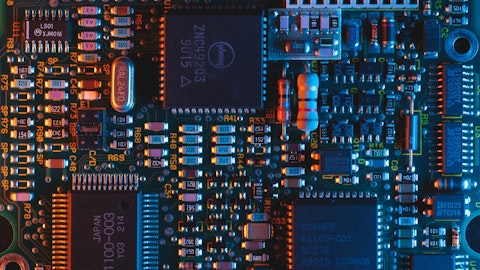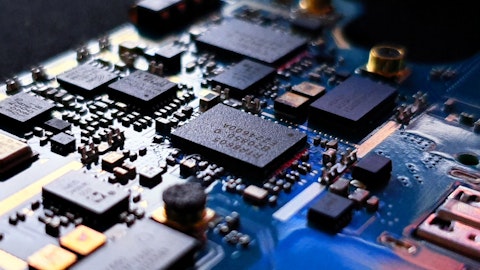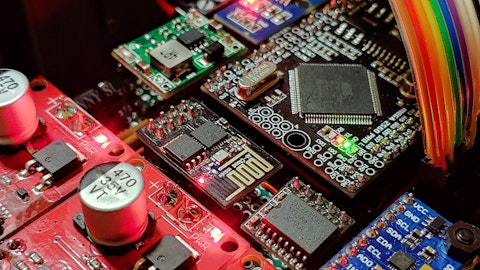Mark Adams: Sure, I’ll start and let Ken jump in as warranted. Raji, thanks for the question. I think the best way to think about it is that there is a broad market opportunity that you can size up AI and I would — one way we look at it is there’s kind of those large companies that will deploy the technologies and systems and not really need or want initial outside services and capabilities that we’d like to provide. And as I’ve mentioned before, and you can see from a comparison on where our gross margins are relative to our competitors, we’re just not going to play that game. That’s just not a good game for us to be in. That’s not what we’re good at. And so, I’d like to think of us as a subset of the AI market where we’re really playing the role of not just the system designer and developer, but the service and trusted advisor consulting type model that we’re full-service end-to-end.
And that’s a small subset of — smaller subset of the bigger pie, because there are large companies that are looking to deploy with their in-house capabilities and that’s something that quite frankly some of our customers will eventually look for us to do more or don’t build their own capabilities and we have to kind of continue to bring on new customers that way. And that’s the dynamic nature of the business. There’s so much activity that way that we’re excited about, our go-forward business. But, we’re not the whole AI market and I want to be transparent. We’re going to be disciplined because at the end-of-the day, I just don’t want to take us through a hardware-only business. That’s not going to be one we’re going to be very profitable nor are we going to be as competitive as we are in the core trusted adviser model.
Raji Gill: Got it. I think that’s really helpful to try to understand the distinction between your model versus say others. Just with respect to the competitive advantage and again you mentioned your focus being on more, kind of, smaller customized solutions. Where do you think, kind of, Penguin Computing ultimate competitive advantage is relative to the other competitors and can you talk about who are you competing with head-to-head. Is that changing at all, given kind of the deployment of AI inside companies? Are you seeing the competitive landscape change? Any thoughts in terms of, kind of, Penguin Computing competitive advantage, and why are you winning. And if you do lose, what are the reasons why you might lose? Thank you.
Mark Adams: Yes, let me do my best with that. And then if I don’t, get to everything just kind of re-ask what I miss. But that’s how we look at it internally. If I kind of broke down the pyramid of engagements that we have and that we’re talking the type of customers we have, the top-tier or the major enterprises looking to deploy AI in the middle tier might be again significantly large enterprises, but not necessarily with the spend at the level of a Tier 1 project. And so it might be considered like a middle tier project. And then, of course, there’s kind of, I would say, early-stage technology deployment, but really more for test of applications and really kind of getting their feet wet. So if you think at three different tiers, we look at each of the opportunities and how we play in them.
I think the differentiation and you asked about competitors. The primary competitors we see out there are Dell, HP, Supermicro. And each one of those is a large-scale hardware player, with margins substantially lower than us in the business today. Now, I’m not here to try to argue whose models per se is better. It’s just what we’re good at and what we’re focused on. Of course, the three companies I mentioned are not the only companies, but they are the examples of what we compete against. And if someone is trying to roll their own internal AI deployments and it’s a hardware-only game, with those folks, that’s the line of business, that’s the margin structure they are set-up to win on. For us, what we’re good at and it comes with 25-years of history of deploying these type of systems and like, we’re not talking about one server and generic software application.
Just yesterday, I was over — we have one of the earliest deployments of liquid immersion technology for a big customer of ours. That’s in our lab, and our differentiation is we’re out in front of the technology, we’re learning about it. So we can bring it to market and we can design it for an environment that we’ve seen before, because over 25-years, a lot of organization, know-how. So whether it’d be on the design side, the actual deployment side, when you think of datacenters and the complexity of connecting massive amount of compute power with the memory, with the storage, with the networking and making sure the right power infrastructure is in place, this is not easy. It’s probably just understated and with 25-years of history of this type of experience and as Ken mentioned, and I mentioned in my script, we’ve had some of the largest AI deployments in the world to-date.
And so when you combine all that, our value-add, yes, we know-how to manufacture these products and systems, sure, but our value-add is how to design them for customer environment, how to deploy it and how to manage it.
Raji Gill: I appreciate that from that insight. And just last question, Ken, just on the model. You mentioned that the IP business ex-Stratus grew 31% so maybe just kind of do the basic math, it looks like Stratus might have been around like $45 million, up in the quarter. Is that kind of the run-rate that you guys are thinking about, $45 million a quarter. And are there — how would you describe some of the growth drivers in the Stratus business?
Ken Rizvi: Yes, so I mean, that business has been just to put it in perspective, last quarter, it did closer to $41 million, this quarter, you are right, it’s closer to that $45 million, $46 million range. So it does move around a little bit quarter-to-quarter to some extent based on some of these hardware deployments relative to Stratus specifically as well. But if we look at it, where has that business has been growing. It’s been growing, primarily at the edge where they have a leading solution for high availability fault tolerant applications. And so, what does that mean and why is that important? If you are trying to run an application and it can’t go down for more than five minutes a year, you go to Stratus and those types of applications can be in the oil refining area, oil, and gas.
They can be in retail. They can be on oil rigs, can be in water treatment plants. But areas where you require a business-critical compute system to run those applications is why customers go to Stratus. That’s where that business has been growing over the last 12 months.




